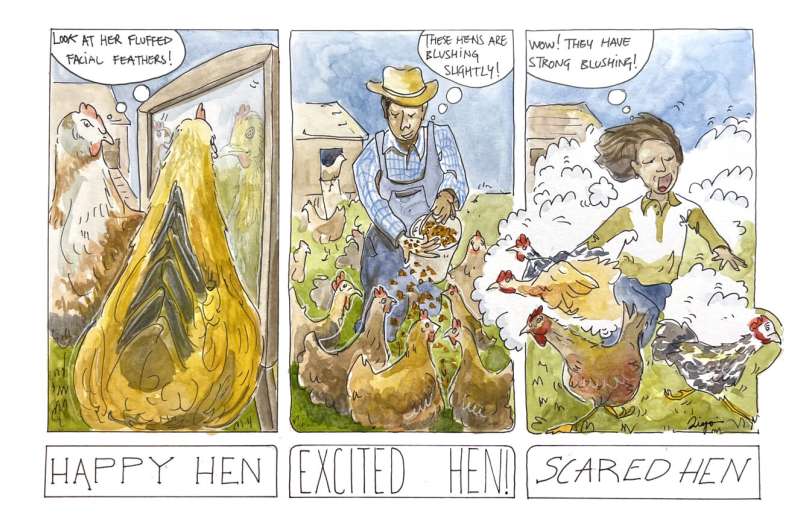
Domestic chickens were analyzed in different scenarios which evoked varied emotions and found to display facial redness (blushing) and facial feather fluffing. Happy, relaxed birds showed preening behaviors and facial feather fluffing. Happy, excited birds displayed slight blushing, while in fearfully excited birds, strong facial blushing was observed. Credit: Diego Perez-Lopez, PLOS, CC-BY 4.0 (creativecommons.org/licenses/by/4.0/)
Hens fluff their head feathers and blush to express different emotions and levels of excitement, according to a study published July 24, 2024, in the open-access journal PLOS ONE by Cécile Arnould and colleagues from INRAE and CNRS, France.
Facial expressions are an important part of human communication that allow us to convey our emotions. Scientists have found similar signals of emotion in other mammals such as dogs, pigs and mice. Although birds can produce facial expressions by moving their head feathers and flushing their skin, it is unclear whether they express emotions in this way.
To investigate, researchers filmed 18 female domestic chickens (Gallus gallus domesticus) from two breeds, as they performed routine behaviors on a French farm. They also filmed the birds while being captured and held by a human, and while being rewarded with an appealing food.
The researchers analyzed the position of their facial feathers and the color of the exposed skin on their faces in seven contexts that differed in their emotional valence and level of excitement. For example, birds preen their feathers when they are relaxed and content, whereas receiving a rewarding food generally causes excitement and happiness, and being captured is an exciting but fearful experience.
The results suggested that the position of the head feathers and the color of the skin varied between contexts. Fluffed head feathers were mainly associated with a state of contentment, whereas blushing indicated that the birds were positively excited or fearful.
Hens tended to have redder skin in contexts associated with excitement, and in those that caused negative emotions. In situations that caused both excitement and a positive emotion, the birds displayed an intermediate skin redness, indicating a continuum of blushing that can convey subtle emotional changes.
The study was the first to investigate facial displays of emotion in chickens, and suggests that domestic hens use facial expressions to show their emotions, much like humans and other mammals do. These findings offer a window into the emotional experiences of domestic birds, which could be used to improve the welfare of farmed poultry, the authors say.
The authors add, “The skin blushing on the face of the domestic fowl is a window into their emotions. The intensity of the blushing varies within a few seconds depending on the emotional situations they experience.”
More information:
Facial blushing and feather fluffing are indicators of emotions in domestic fowl (Gallus gallus domesticus), PLoS ONE (2024). DOI: 10.1371/journal.pone.0306601
Citation:
Study shows chickens use flushed skin and feather fluffing to display different emotions, levels of excitement (2024, July 24)
retrieved 24 July 2024
from https://phys.org/news/2024-07-chickens-flushed-skin-feather-fluffing.html
This document is subject to copyright. Apart from any fair dealing for the purpose of private study or research, no
part may be reproduced without the written permission. The content is provided for information purposes only.
>>> Read full article>>>
Copyright for syndicated content belongs to the linked Source : Phys.org – https://phys.org/news/2024-07-chickens-flushed-skin-feather-fluffing.html































